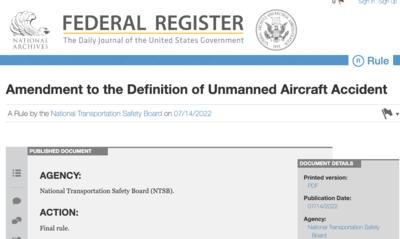Wed, Aug 03, 2022
Airworthiness Certification Replaces Weight Consideration to Better Address Growing Commercial UAVs
The NTSB has addressed shortcomings in the previous definition of “unmanned aircraft accident” in a recently published rule to go into effect August 15.

The change is designed to help to address recent developments within the industry that have made the previous weight-based definition somewhat lacking when determining agency response to aircraft accidents. Under the older definition, an “unmanned aircraft accident” was an incident associated with the operation of an unmanned aircraft. An accident unter that definition included any incident in which an active, operational UAV is substantially damaged or associated with death or serious injury. A key dissatisfaction with the definition lay in the requirement that the UAV have a MGTOW of 300 lbs or greater, an addition that originally sought to limit the amount of busywork sent to the NTSB for small aircraft. Things have changed, however, with a bevy of uncrewed flight operations quickly becoming the norm across a raft of industries looking to shorten their logistics chain or enhance service coverage for customers.
In May of 2021, the NTSB issued an NPRM proposing a change that would eliminate the weight requirement, instead replacing it with an airworthiness certificate or approval requirement. The NTSB said that the weight threshold is “no longer an appropriate criterion," stating that many uncrewed systems under 300 lbs are "operating in high-risk environments, such as beyond line-of-sight and over populated areas." The NTSB explained that the new proposed definition would improve their ability to respond to significant safety events and advance the state of the industry as a whole, particularly in light of the expanding field of drone-based delivery services. Commercial operations using drones have been a point of concern from the public comment period, with the NTSB’s release quoting a citizen’s desire for UAS operations to be “subject to the same scrutiny as commercial manned operations.”
“A substantially damaged delivery drone may uncover significant safety issues,” says the newly released Final Rule. “The investigation of which may enhance aviation safety through the independent and established NTSB process. This amended definition will treat a UAS with airworthiness certification in the same manner as a manned aircraft with airworthiness certification, thereby enabling the NTSB to immediately investigate, influence corrective actions, and propose safety recommendations.”
The rule in its entirety has been published to the Federal Register under docket number NTSB-2021-0004.
More News
Aero Linx: Aviators Code Initiative (ACI) Innovative tools advancing aviation safety and offering a vision of excellence for aviators. The ACI materials are for use by aviation pra>[...]
Make Sure You NEVER Miss A New Story From Aero-News Network Do you ever feel like you never see posts from a certain person or page on Facebook or Instagram? Here’s how you c>[...]
From 2016 (YouTube Edition): Who You Gonna Call When You Have a Rocket Engine that Needs a Spacecraft? While at EAA AirVenture 2016, ANN CEO and Editor-In-Chief, Jim Campbell, sat >[...]
"In my opinion, if this isn't an excessive fine, I don't know what is... The odds are good that we're gonna be seeking review in the United States Supreme Court. So we gotta muster>[...]
Expedite Used by ATC when prompt compliance is required to avoid the development of an imminent situation. Expedite climb/descent normally indicates to a pilot that the approximate>[...]
 ANN's Daily Aero-Linx (04.30.25)
ANN's Daily Aero-Linx (04.30.25) ANN FAQ: Turn On Post Notifications
ANN FAQ: Turn On Post Notifications Classic Aero-TV: Agile Aeros Jeff Greason--Disruptive Aerospace Innovations
Classic Aero-TV: Agile Aeros Jeff Greason--Disruptive Aerospace Innovations Aero-News: Quote of the Day (04.30.25)
Aero-News: Quote of the Day (04.30.25) ANN's Daily Aero-Term (04.30.25): Expedite
ANN's Daily Aero-Term (04.30.25): Expedite



